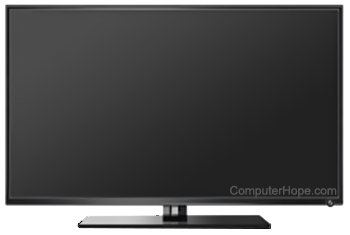How to fix "no input signal" error message
Updated: 06/30/2020 by Computer Hope

If your computer monitor is displaying the error message "No Input Signal," try the troubleshooting options in the sections below.
Computer not transmitting a signal
Make sure the computer has power. If the computer is turned off, it cannot transmit a signal and causes the "no input signal" message.
Monitor not connected properly
Verify the monitor cable is connected correctly and securely on the back of the monitor and the back of the computer. The monitor cable connects to the back of your computer using either a VGA, DVI, HDMI, or DisplayPort connector. The pictures below are examples of the VGA, DVI, HDMI, and DisplayPort connectors on a video card.



Verify the monitor cable is not loose by disconnecting the cable from the back of the monitor and reconnect the cable. It's also a good idea to rock the cable back and forth to make sure it's not loose.
Tip
When disconnecting the cable, make sure none of the cable's pins are bent by examining the end of the cable. If any of the cable's pins are bent or broken, the cable may be defective and should be replaced.
Note
Some older monitors may have cables that cannot be disconnected from the back of the monitor.
Next, disconnect the monitor cable from the back of the computer and reconnect the cable. When connecting the cable to the computer, ensure the cable connection is tight. With a VGA or DVI style connector, like the ones shown above, screws can be tightened and hold the connector in place.
Tip
Some computers may have an onboard video and a video card. When working with this type of computer, you'll have two different connections for your monitor on the back of your computer. If you see more than one VGA, DVI, HDMI, or DisplayPort connector and the monitor is not working, try the other connector.
Incorrect input selected
Newer monitors are capable of connecting to a computer using a VGA, DVI, HDMI, or DisplayPort connector. For these types of monitors, the correct input selection needs to be used. Access the settings on the monitor using the buttons on the front or bottom edge of the monitor. Look for options to select the type of connector (e.g., VGA, DVI, HDMI, or DisplayPort), and select the cable your monitor uses.
Bad hardware
If the connections appear to be correct, either the monitor or the video card is likely bad. It's also possible that the motherboard in the computer is defective, preventing a signal from getting to the video card and monitor. To test what component is bad, either connect a different monitor to your computer or connect your monitor to a different computer. We recommend testing the motherboard for any issues, as well. See: How to test a computer motherboard and CPU for failures.
- If another monitor works on your computer, the monitor is bad.
- If your monitor works on another computer, your video card may be having issues. See: My video card isn't working.
Computer not posting
Verify your computer is getting past the POST process and that it is starting up. The "No input signal" message can sometimes appear if the POST process is failing, and the computer cannot boot properly.
If the POST process is failing and the computer is not starting up, the motherboard could be at fault. A short in the motherboard or a bad capacitor are common causes for a computer motherboard to not pass the POST process.
Monitor works for a while, then loses signal
If the monitor works for a while, then stops working and displays the "No input signal" message, the monitor or computer may be overheating. In the event of the monitor overheats, it stops working to prevent further damage. If the computer overheats, the computer may stop sending a signal to the monitor, and may also shut down to prevent further damage to the computer hardware.
Fixing a monitor that is overheating is generally not worthwhile. The cost to fix it is likely more than the cost of buying a new monitor. For that reason, we recommend replacing an overheating monitor.
If the computer is overheating, the fans that keep the processor, video card, or power supply cool may have failed. Check the fans to see if they are spinning. If they are not spinning at all when the computer is turned on, the fans need to be replaced. If the fans are spinning, use a software diagnostic tool, like HWMonitor, to determine if the fans are spinning at the correct RPM. It is possible that the fans are not spinning fast enough, indicating they are bad or full of dust and need to be cleaned or replaced.
- How to tell how hot my CPU is running.
- How to tell the temperature of a video card.
- Why is the fan not spinning in the computer power supply?
If the overheating is related to the computer processor, you may need to replace the heat sink and fan assembly. It's possible that the CPU may be damaged and needs to be replaced, as well.
For a video card or power supply, the fans are usually integrated into the hardware and not easily replaced, if they can be replaced at all. You may need to replace the power supply or video card to fix the overheating problem.
Source: https://www.computerhope.com/issues/ch000438.htm
Posted by: brigetteaboshihatae0194563.blogspot.com

0 Comments